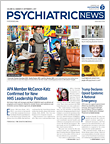While there has been a big surge of interest in low-intensity transcranial electrical current stimulation (tCS) for psychiatric use, a review article published July 1 in AJP in Advance showed mostly disappointing results.
“There is still a fair amount of work to be done before these devices are ready for prime time,” said principal investigator Noah S. Philip, M.D., an associate professor of psychiatry and human behavior at the Warren Alpert Medical School of Brown University.
Philip and his team of researchers conducted a review of published clinical data extracted from PubMed, recent review articles, and meta-analyses, that included only treatment-based, randomized, controlled trials and key proof-of-concept studies. The literature search, performed on March 24, 2016, and updated on November 21, 2016, looked for modality terms separately and in combination with the following psychiatric disorders: major depression, schizophrenia, dementia and cognitive disorders, and substance use disorders.
The best-known type of tCS is transcranial direct current stimulation (tDCS), and the majority of tCS clinical trials tested tDCS. Available evidence from randomized, controlled trials generally supported the use of tDCS to relieve symptoms of depression, while other stimulation modalities produced a range of results.
“The literature we reviewed showed a mixed bag of results; tDCS might be effective for depression, but not definitely. Once you get outside the world of depression, it’s not clear what could happen,” said Philip, who became interested in tCS after some of his patients requested the low-intensity brain stimulation treatment.
The use of tCS carries some physical and psychiatric risks (see sidebar), according to the review, and the authors cautioned, “At this time, enthusiasm for tCS in clinical practice settings should be mitigated by the fact that there are no transcranial direct current stimulation (tDCS) devices with FDA clearance for treatment of psychiatric disorders.”
Some older cranial electrotherapy stimulation (CES) devices were FDA cleared (such as models made by Alpha-Stim and Fisher-Wallace) for insomnia, depression, and anxiety, but these devices were grandfathered in when standards were lower, said Philip, who is also director of psychiatric neuromodulation at Providence VA Medical Center.
Despite their FDA indication for depression, CES devices have not consistently demonstrated clinical efficacy or have only limited support from “low-quality” evidence (studies not controlled or monitored adequately, not blinded), he said.
How Does Neurostimulation Work?
Neurostimulation targets electrical activity in the brain networks. Regardless of the waveform, the reviewers noted that the electrical resistance of the pathway through the patient’s tissues determines how much voltage the device applies to achieve the level of current selected by the clinician.
“Compared with electroconvulsive therapy (ECT), which is limited by anesthesia and risk involved in having a seizure, these devices are much less invasive, very different from making the whole brain fire,” said Philip. “They just give neurons a little bit of a nudge.”
Still, Philip said he would not use currently available tCS devices on his patients and has used them only for research purposes.
The positioning of the stimulation electrodes on the scalp can suggest the misleading perception that only the brain underneath the electrodes and no other area is stimulated. This is mostly incorrect, Philips and colleagues wrote, because the human head exhibits heterogeneous electrical properties. When the current is delivered through scalp electrodes, a large part of it is shunted away through the skin and does not penetrate the skull. The current may also travel through the orbits, foramen magnum, or cranial nerve foramina.
Given the distributed and complex deficits in neuronal networks associated with psychiatric disorders, identifying the correct target areas for therapeutic stimulation in a specific disorder or symptoms remains an important challenge for the field, the authors asserted.
Data on tCS for Psychiatric Disorders Unconvincing
Currently available data do not support the use of tCS for schizophrenia. The results of most clinical randomized, controlled trials also have been negative for dementia or cognitive deficits. However, a 2016 study in the journal Movement Disorders found that tDCS improved cognition in patients with Parkinson’s disease.
Questions remain about potential side effects or synergistic therapeutic effects when tCS is combined with psychotropic medications, and no large studies have investigated the use of tCS along with adequate doses of antidepressant medication. Available data do not support the use of tDCS as a method to accelerate or enhance the short-term effects of psychotherapy.
“If eventually proven safe and effective, with appropriate regulatory controls and guidelines for clinical monitoring, the relative ease of use and easy access to devices could make tCS a broad-reaching and important advance in mental health care,” the review concluded.
The research was supported by Neuronetics, Cervel Neurotech, Neosync, Tal Medical, and Janssen. ■
“Low-Intensity Transcranial Current Stimulation in Psychiatry” can be accessed
here.

